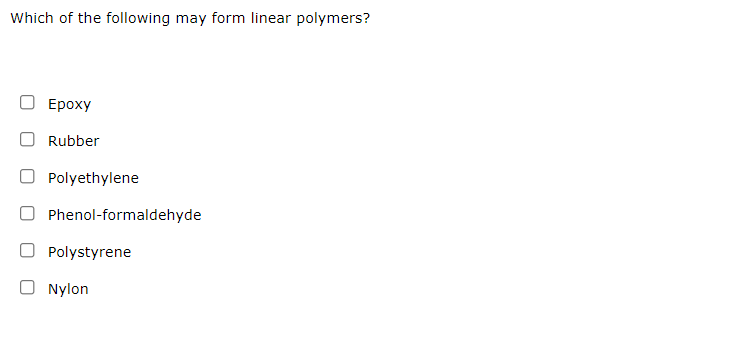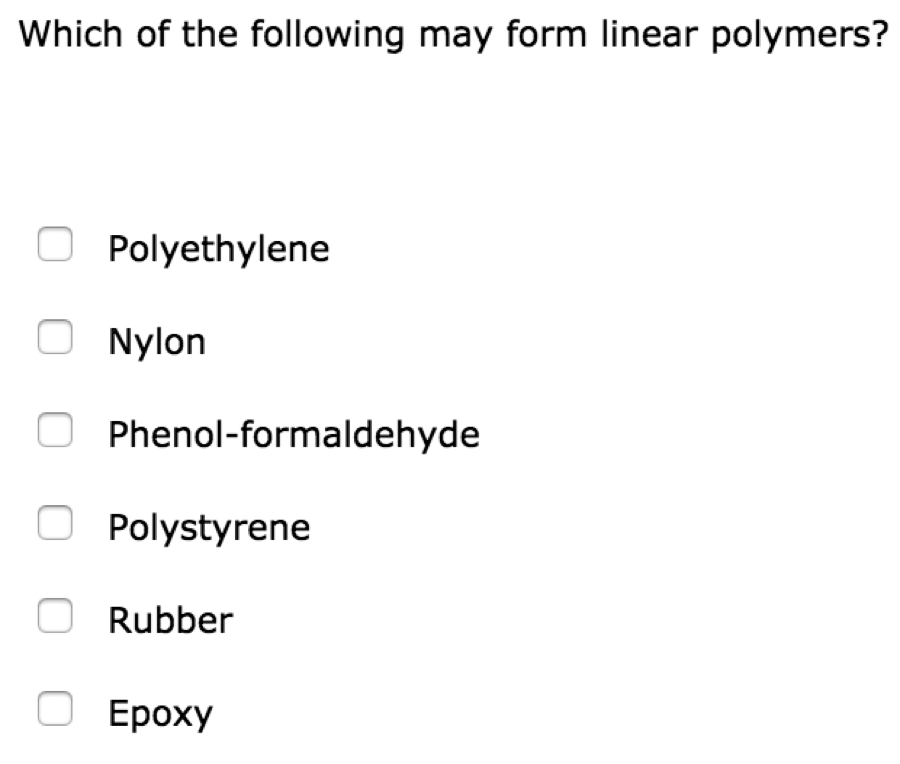Which of the Following May Form Linear Polymers
Greek poly- many -mer part is a substance or material consisting of very large molecules or macromolecules composed of many repeating subunits. Linear viscoelasticity is a theory describing the behaviour of such ideal materials.

Solved Which Of The Following May Form Linear Polymers Chegg Com
1 POLYMERS Polymers are the high molecular weight compounds obtained by repeated union of simple molecules.

. The word Polymer is derived from two Greek words Poly that means many numerous and Mer which means units. Change in chemical structure - Natural weathering is normally an oxidative degradation which produces hydroperoxy hydroxy carbonyl groups and cross-linking which can be detected by IR UV and NMR spectroscopy. What types of foods are fructans found in.
Also the polymerization reactions for Nylon 6 and Spandex do not proceed by elimination of water or other small molecules. At any given time say t1 the strain is proportional to stress. Properties of shape-memory polymers.
Poly means many and mer means unit or part. The following examples of condensation polymers are illustrative. Polypropylene is one of those most versatile polymers available with applications both as a plastic and as a fibre in virtually all of the plastics end-use markets.
Upon disposal in bio-bins and exposure to a bioactive environment BPs will biodegrade to natural substances such as CO 2 water humic matter and biomassNew agricultural crops using nutrients from compost and fixing CO 2 will produce new polymer. As well as polymers in general SMPs also cover a wide property-range from stable to biodegradable. When linear chains of a.
These fructose polymers come in 2-9 units length which are called oligofructose as well as 10 units length which are called inulins2. Note that for commercial synthesis the carboxylic acid components may actually be employed in the form of derivatives such as simple esters. The term polymer is defined as very large molecules having high molecular mass.
The structure of polymers containing long and straight chains fall into this category. PP like polyethylene see HDPE LLLDPE and polybutene PB Polypropylene is a polyolefin or saturated polymer. Naturally occurring carbohydrates in the form of linear or branched fructose polymers1.
Due to their broad spectrum of properties both synthetic and natural polymers play essential and ubiquitous roles in everyday life. Figure 1 Cyclic process by which agricultural products and fermentative routes can yield biodegradable polymers. A polymer ˈ p ɒ l ɪ m ər.
Polymers range from familiar synthetic plastics such as polystyrene to. Polymers may be naturally found in plants and animals. Starch Polyvinyl chloride Polyethylene Nylon 6 6 and etc.
These identical structures we understand as a unit made up of two or more molecules join together to form a. Strain-time curves for various constant stresses are shown in the following figure for a linear viscoelastic material. Poly-vinyl chloride is largely used for making pipes and electric cables is an example of a linear polymer.
In basic terms a polymer is a long-chain molecule that is composed of a large number of repeating units of identical structure. SMPs can retain two or sometimes three shapes and the transition between those is induced by temperature. Change on surface - Most of the oxidative degradation takes place at the surface of polymeric material because oxidative processes are.
This category has the following classifications. Linear viscoelastic materials are those for which there is a linear relationship between stress and strain at any given time. The word Polymer is coined from two Greek words.
Polypropylene PP is a linear hydrocarbon polymer expressed as CnH2n. Foods that are high in fructans may include wheat productssuch as bread and pastaonions shallots garlic barley. In addition to temperature change the shape change of SMPs can also be triggered by an electric or magnetic field light or solution.

Solved Which Of The Following May Form Linear Polymers Chegg Com

Which Of The Following Is A Linear Polymer


Belum ada Komentar untuk "Which of the Following May Form Linear Polymers"
Posting Komentar